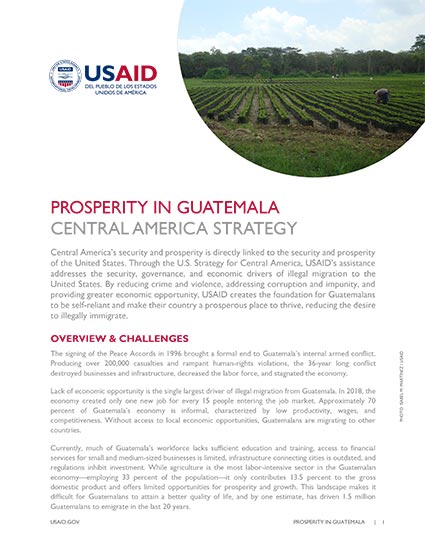Speeches Shim
Central America Strategy
USAID works with the people of Guatemala to improve health and education outcomes and create new opportunities for investment, job growth, and expanded markets.
Working closely with government institutions, USAID and its partners implement a wide-range of projects to address the major issues hindering prosperity in Guatemala. To reduce illegal immigration, end poverty, and increase employment, USAID’s projects focus on: 1) promoting economic growth and resilience; 2) creating income-generating opportunities; and 3) strengthening health and education.
History & Context
The signing of the Peace Accords in 1996 brought a formal end to Guatemala’s internal armed conflict. However, the 36-year long conflict destroyed businesses and infrastructure, decreased the labor force, and stagnated the economy. Lack of economic opportunity is the single largest driver of illegal migration from Guatemala. In 2018, the economy created only one new job for every 15 people entering the job market. Approximately 70 percent of Guatemala’s economy is informal, characterized by low productivity, wages, and competitiveness. Without access to local economic opportunities, Guatemalans are migrating to other countries.
Currently, much of Guatemala’s workforce lacks sufficient education and training, access to financial services for small and medium-sized businesses is limited, infrastructure connecting cities is outdated, and regulations inhibit investment. While agriculture is the most labor-intensive sector in the Guatemalan economy—employing 33 percent of the population—it only contributes 13.5 percent to the gross domestic product and offers limited opportunities for prosperity and growth. This landscape makes it difficult for Guatemalans to attain a better quality of life, and by one estimate, has driven 1.5 million Guatemalans to emigrate in the last 20 years.
Programs
- Research Grant to the International Food Policy Research Institute (IFPRI)
- Climate, Nature, and Communities in Guatemala Project
- Strengthening Governance in the Maya Biosphere Reserve
- Feed the Future Guatemala Innovative Solutions for Agricultural Value Chains Project (PRO-INNOVA)
- Feed the Future Guatemala Coffee Value Chains Project
- Creating Economic Opportunities (CEO)
- Rural Extension
- Biodiversity Project
- Lifelong Learning Project
- Puentes Project
- Advance Project
- Health and Education Policy Project Plus (HEP+)
- Global Health Supply Chain for Procurement and Supply Management
- Centers for Disease Control and Prevention Inter Agency Agreement II
- Water Quality Improvement in the Mam territory and Institutional Strengthening of the Mancomunidad de la Cuenca del Rio Naranjo (Mancuerna)
- Breakthrough Action Nutrition Project
- Global Health Supply Chain for Procurement and Supply Management
- Central American Project for Sustaining and Championing the Human Rights Response
- Strengthening Care and Treatment Cascade Project
- Sustainable HIV Knowledge Management


Comment
Make a general inquiry or suggest an improvement.